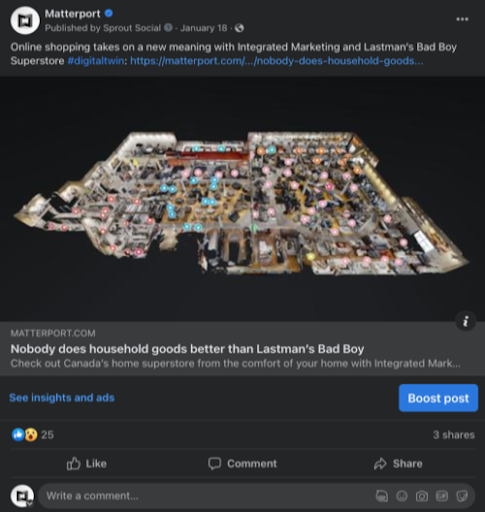Social Media Marketing for Real Estate Agents: Strategies & Examples to Help Build Your Network
Gone are the days of tirelessly capturing a property with flat photos; it's time to transform how you showcase your residential real estate listings so that they can stand out in a digitally driven, socially networked world.
In this article, we'll explain how you can set your real estate business apart (and up for success) on social media, particularly withMatterport.
Why real estate agents should use social media marketing
Social media has become essential for connecting with today's tech-savvy buyers and sellers—even more than real estate advertising. The reasons below show just how powerful these platforms can be for real estate professionals who want to be competitive and grow their client base.
Reach potential home buyers, sellers, and renters where they are
Nearly everyone is online these days. Around 72% of American adults use social media, and most buyers—99% of millennials and 90% of baby boomers—start their home search online. If you're not active on social, you're missing a huge opportunity to connect with them where they're already looking.
Your peers already leverage social media
Most realtors, particularly those who are successful, are already ahead of the game when it comes to social media. And platforms like Facebook, Instagram, and LinkedIn are popular tools for marketing properties, especially with 57% of agents actively using social media in some way.
Plus, another study revealed that social media accounts for 52% of high-quality leads in real estate. If your competition is there, you need to be, too—or you'll miss out.
Take advantage of technology to set yourself apart
Real estate has evolved so much over the last few years that, at this point, virtual tours and 3D imagery aren't just trendy—they're what buyers expect.
Homes with 3D tours get 49% more qualified leads, and solutions like Matterport's Digital Pro package give you everything you need to make your listings stand out. So, if you want to wow potential clients during their homebuying experience, this is how you do it.
7 social media channels to grow your real estate marketing business
There are so many social media platforms out there that it's easy to feel overwhelmed. Don't worry—we've got you. Let's walk through the platforms that can help you reach your audience and how to create content that actually grows your online presence.
1. Facebook
Facebook has a huge user base and tons of features, and that's why it's a powerful platform for digital marketing.
Audience: Facebook has a diverse (and vast) user base with demographics spanning millennials, Gen X, and baby boomers.
Content types: Facebook supports a versatile range of formats, such as images, videos, and long-form text posts.
How to succeed: Create a business page if you haven't already, and engage your audience. Start sharing new listings and market updates, post events for virtual tours and open houses, and make sure to engage with potential customers—especially on Facebook groups—by responding to comments and returning messages promptly. And, of course, your social media team should already be familiar with including hashtags and geotags to make your posts more discoverable on Instagram.
Example:

See the original post on Facebook here
Why it works/what could make it even better:
High-quality images and videos of property interiors and exteriors
Live videos for open houses and events
Long-form posts or articles about the home buying/selling process and the real estate market
2. Instagram
As a visually-focused platform, Instagram is perfect for showcasing your properties.
Audience: Instagram's user base skews younger, primarily millennials and Gen Z, so it's a good bet for reaching first-time home buyers.
Content types: It’s a visual medium, so you need Instagram posts with high-quality images and short videos. Also, don’t forget about Instagram stories and reels.
How to succeed: The look and feel of your profile is everything. That means choosing a high-quality profile picture, writing a compelling bio, and sticking with a unique visual style and color scheme for your posts.
Example:
